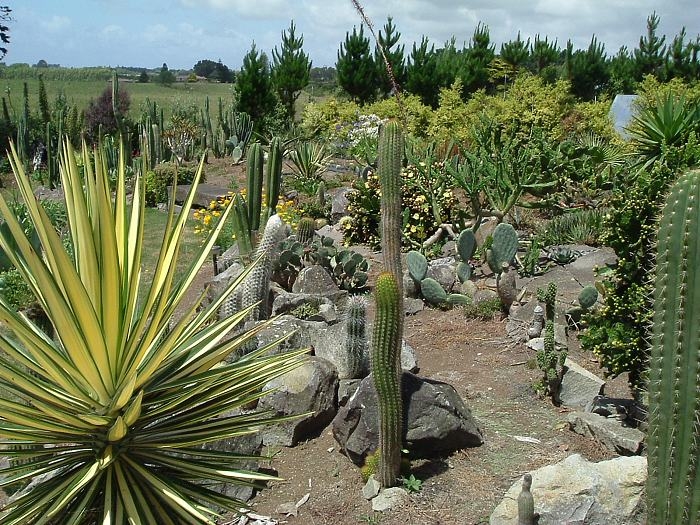This is the outline for a presentation on the subject at Magnolia Grove for the Rhododendron and Garden Festival 2010
BOTANICALLY SIMPLE:
We have a few main plant families that create the basic structure.
Agave 20, Aloes 33, Cereus types (columnar) 20, Opuntiods(prickly pear types) 21, Yuccas 7.
The Desert Garden at Magnolia Grove has been through at least minus 5 Celsius.
The hardy range of basic species allows the range of interesting shapes and textures.
Full sun is essential, and good air circulation is important for fast drying in our climate
PROPAGATION:
The methods of propagation are quite dependant on the shape or structure of the plant.
Plant into a well drained mix in containers, or cuttings and divisions can be planted into the ground from November to January.
SEED:
This is mainly for solitary plants of normally clumping families or for non branching cacti.
NEVER SOW SEED IN CONTAINERS SHALLOWER THAN 8CM. CLICK HERE TO SEE WHY.
SURFACE SOW, COVER WITH 3MM GRADE PUMICE. AS FOR ANY OTHER SEED: WARM AND HUMID UNTIL GERMINATED. Numbers can be built up quickly from seed propagation. When collecting seed, the black seeds are generally the good ones. Surplus seedlings are useful to experiment for hardiness.
CUTTINGS:
Most cacti can be grown from cuttings and the stem forming succulents can be grown from cuttings. HANDLING THE PRICKLY ONES:
Thick gloves, tongs and rolled paper are useful for handling plants and cuttings.
ALLOW ALL CUT SURFACES TO DRY BEFORE PLANTING…AT LEAST A WEEK FOR CACTUS CUTTINGS
DIVISION:
This method is used for clumping species like Yuccas, Aloes and Agave.
TRANSPLANTING:
The shape and size of the plant dictates the handling proceedure.
Slings are helpful for carrying.
Stakes and small posts are useful for temporary support. Support wires for very large plants.
Rocks and stones are useful for permanent support.
MAINTENANCE AND GROOMING:
Feed IN SPRING with balanced fertiliser for establishment phase, Nitrophoska is good. Potassic superphosphate for established plantings.
For the formal look, remove dead flower heads and older leaves. On yuccas and dragon trees, do not remove leaves higher than the mature stem.
On the mature part of the stem the leaves remove more easily.
For the natural look, leave dead flower heads and allow a skirt of dead leaves to develop, especially on tree yuccas.
PRUNING:
Pruning is really advanced grooming. A sharp spade and fork are useful for handling surplus material.
PESTS AND DISEASE:
These are not usually a problem in the open. Scale insects and aphids can be a problem sometimes.
Some species naturally develop a scaly bark with age.
WEED CONTROL:
This is most easily achieved with a rock or pebble mulch on a smaller scale, but on a larger scale bare ground and chemical sprays are effective if used carefully.

